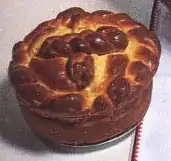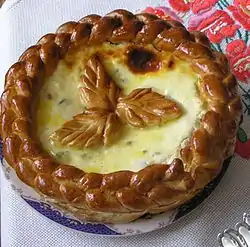Paska (bread)
Paska (Ukrainian: пáска, romanized: páska, Georgian: პასკა, romanized: paska, literally: "Easter"; Romanian: pască; ultimately from Imperial Aramaic: פסחא, romanized: pasḥā, literally: "Passover")[1] is a sweet decorative bread native to Ukraine.[2] It is a variation of Easter bread, a tradition particularly spread in countries with predominant Eastern Orthodox religious or cultural connections to the ancient Byzantine Empire. Paska breads are a traditional element in the Easter holidays of Ukraine, Armenia, Belarus, Romania, Russia, Georgia, Moldova and parts of Bulgaria, as well as Turkey, Iran and the Assyrian-Chaldean-Syriac diaspora. Due to its geographical closeness, it is also widespread in Slovakia. Meanwhile, it is also eaten in countries with immigrant populations in Eastern Europe such as the United States, Canada and the United Kingdom.
 | |
| Type | Sweet bread |
|---|---|
| Place of origin | European / Eurasian countries with predominant Orthodox religion |
| Main ingredients | Milk, butter, eggs, sugar |
Etymology and origins
In the Ukrainian language Easter is called Вели́кдень (Velýkden'). The term paska comes from the Greek word of Easter (from which it has also entered Russian as па́сха (páskha).[3]
The Ukrainian word па́ска (páska) is one of the words used for a traditional egg enriched Easter bread or cake in Ukraine, whilst Вели́кдень (Velýkden') is used to denote the day.[4][5]
In some diaspora communities the term paska is used for braided loaves, while the tall breads resembling Russian kulich are called baba or babka.[6] Among different communities and families it may be used variously for the braided, elaborately decorated loaves of Easter bread, or the tall Easter cake cooked in tin cylinders sometimes called babka, baba or in Russian, kulich.[7]
Christian symbolism

In the Mennonite communities of North America, the act of baking the paska bread was a ritual that commemorated the resurrection of Christ.[8]
The Christian faithful in many Eastern Christian countries eat this bread during Easter. Christian symbolism is associated with features of paska type breads. Other versions include chocolate, rice, or even savoury mixtures based on cheese. A version is made with maraschino cherries added to symbolize royal jewels in honor of the resurrection of Jesus.[9]
Traditional ingredients

Paska is made with milk, butter, eggs, flour, and sugar, except for the Romanian pască where the recipe most commonly includes sweet cream, cottage cheese, and/or sour cream along with eggs, sugar, raisins, and rum. An egg and water mixture is used as a glaze.
Ukraine

In Ukraine[10][11] it is tradition to fill your Easter basket (koshyk) with Easter eggs (pysanky), Easter bread (paska), sausage (kovbasa), butter, salt and other ceremonial foods on Holy Saturday (Easter Eve). On Easter morning, after the liturgy and the blessing of the paska and other staples, everyone returns home to feast on the eggs, cold meats, and other goods that were blessed at church.[12] After the matins all the people in the congregation exchange Easter greetings, give each other krashanky, and then hurry home with their baskets of blessed food (sviachene). In the east of Ukraine they go home, place the sviachene on the table, and the oldest member of the family opens the cloths in which the food is wrapped, slices pieces from each item, and distributes them to members of the family along with a piece of unleavened bread that has also been blessed.
In the west of Ukraine, especially in the Hutsul region, the people first walk around the house three times. Only then do they enter the house, ceremoniously open the bundle (dorinnyk) over the heads of the children, and sit down to the table to break their fast.[4] Modern pasky usually have a white glaze made from sugar and egg and are decorated on top with coloured wheat grains or poppy seeds. However, an old custom, which is still practised in some Ukrainian regions and diasporas, is to create dough ornaments for the paska. The symbolism of these ornaments is connected with spring themes: the awakening of nature, resurrection and rebirth. Birds, especially larks, as heralds of spring, took a much-deserved place on pasky.[13]
Eaten with other foods
Paska is eaten with hrudka, also called syrek, a bland sweet custard similar to cheese made from separated eggs and milk and beets mixed with horseradish (chren/hrin) and kovbasa.
Pască
 Pască with cheese | |
| Type | Pastry |
|---|---|
| Place of origin | Romania, Moldova |
| Main ingredients | eggs, sour cream, fresh cheese, raisins, sugar |
Pască is a traditional Romanian and Moldovan pastry.[14] Especially made for Easter, pască is a tart with a cozonac dough base filled with fresh cheese like urdă or cottage cheese, raisins, eggs and sugar. Other variants include sour cream, chocolate, or berries fillings.[15]
See also
References
- "Артос: пасхальный хлеб". Православный журнал "Фома". 2018-04-14. Retrieved 2019-02-25.
- Hudgins, Sharon (2018). T-bone whacks and caviar snacks : cooking with two Texans in Siberia and the Russian Far East. University of North Texas Press. ISBN 978-1-57441-714-2. OCLC 1013516614.
In Russian, paskha is the word for Easter; in Ukrainian, the word is spelled paska. For Russians, paskha is the also the name of a special cheese dessert made only for Easter, always accompanied by the Russian Easter bread kulich, a tall, cylindrical, yeast-raised, sweet bread decorated with white icing. For Ukrainians, however, paska is the name of their own Easter bread.
- Krondl, Michael (2011). Sweet Invention: A History of Dessert. Chicago Review Press. p. 125. ISBN 9781556529542. Retrieved 25 September 2015.
- "Easter". www.encyclopediaofukraine.com.
- "Пасха, Паска чи Великдень? 5 помилок в українській мові, яких соромно припускатися". 1plus1.ua. 18 March 2019.
- Kononenko, Natalie (2023). Ukrainian Ritual on the Prairies: Growing a Ukrainian Canadian Identity. McGill-Queen's University Press. p. 224.
- Linguistics in North America, 1. De Gruyter. 1973. p. 618. ISBN 9783111418780.
- Epp, Marlene (2008). Mennonite women in Canada a history. Winnipeg: University of Manitoba Press. ISBN 9780887554100.
- Joan Halmo Celebrating the church year with young children Liturgical Press, 1988 ISBN 978-0-8146-1580-5. 159 pages. page 43
- Hudgins, Sharon (2018-05-15). T-Bone Whacks and Caviar Snacks: Cooking with Two Texans in Siberia and the Russian Far East. University of North Texas Press. ISBN 9781574417227.
- "Ukrainian Easter Bread". Martha Stewart. 2011-07-25. Retrieved 2019-03-02.
- "Traditional foods". www.encyclopediaofukraine.com.
- "Tradition of Paska – Ukrainian Easter Bread". Archived from the original on 2019-11-07. Retrieved 2019-11-07.
- definition of pască (in Romanian) dexonline.ro
- "Pască pentru Paște - idei de rețete pentru pască tradițională cu brânză dulce sau cu ciocolată". www.libertatea.ro (in Romanian). April 19, 2022.
External links
 Media related to Paska (bread) at Wikimedia Commons
Media related to Paska (bread) at Wikimedia Commons- Paska recipe at the Wayback Machine (archived 28 March 2016)